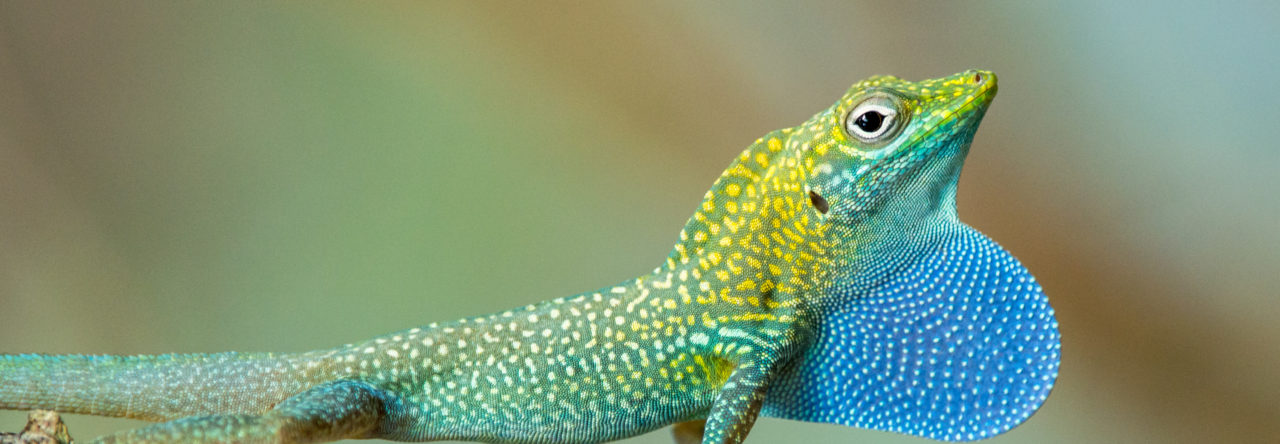No flies on you guys–this remarkably obscure anole was quickly identified. So, what’s its claim to fame?
Well, we have to backtrack to Anolis onca for a minute. Faithful AA readers will recall that A. onca is the only anole lacking a subdigital toepad. For this reason, at one point it was placed in its own genus, Tropidodactylus. However, in 1974 Ernest Williams described a new species in Breviora based on a single specimen found in a jar of A. onca in the Field Museum in Chicago. At that time, Anolis was characterized by having expanded scales under phalanxes ii and iii of the toe, whereas Tropidodactylus, of course, had none (phalanxes are the bones in a toe–humans have three per finger, for example). What was remarkable was that the new specimen had expanded scales under phalanx ii, the Anolis condition, but only keeled scales under phalanx iii–it was intermediate between the two, hence the specific name annectens. Here’s an image from Williams’ paper and a photograph of an annectens toe.
The term “retrograde” comes from Williams’ paper and refers to the idea that A. annectens and A. onca illustrate a morphocline in toepad reduction–halfway gone, then all the way gone. Incidentally, recent molecular studies confirm that the two species are sister taxa.
Amazingly enough, A. annectens occurs in the same general region as A. onca, near Lake Maracaibo in Venezuela. In 2007, Tito Barros and colleagues reported in Tropical Zoology on the collection of an additional 22 specimens of A. annectens, confirming that the one individual wasn’t a freak. They also provided information on coloration, geographic distribution (it still hasn’t been found in sympatry with A. onca) and some data on ecology.
Since we were in the area any way, we decided to go and look for them after collecting data on A. onca. By “we,” I mean Tito Barros, Gilson Rivas, several students of theirs, and Rosario Castañeda. Anthony Herrel was busy back at the field lab conducting performance trials (sprint speed, bite force), and I was on assignment finding discarded cardboard boxes to make a proper racetrack.
The weather was beastly hot, about 110 degrees Fahrenheit, with no wind. Here’s what Rosario had to say:
“After a late start, thanks to the repairs our car needed, we headed out towards La Ceiba, in the state of Zulia, Venezuela. After a two-hour drive, we arrived past noon to a secondary forest in 40 C degree weather. Though the conditions were not very promising, as the dry season has been longer than usual and the scorching heat was not forgiving, the infallible anole finder Raul González spotted the first A. annectens after just a few minutes searching! We only found five individuals (four of us were searching) in a 4-hour period; all of them were in the shade, probably avoiding the heat, perched between 10-82 cm of height, and showing very little activity. At the end of the day, we left without seeing any displays or interactions, but we got to see those ‘intermediate’ annectens toepads, totally worth it!”
One final note: like A. onca, A. annectens has blue coloration in the corner of its mouth, though not as vivid as in its sister.
- Evolution in Real Time on Lizard Island - March 23, 2025
- Spider Snags Adult Anolis osa - March 22, 2025
- An Homage to the Green Anoles of New Orleans - March 21, 2025






Kevin de Queiroz
One minor correction: The toepads of anoles are under phalanges iii and iv, not ii and iii (see de Queiroz, Chu, & Losos, 1998, American Museum Novitates no. 3249), a common error that apparently derives from the work of E. E. Williams. It’s an easy mistake to make because the terminal or ungual phalanx is very small and is more-or-less only invested by the claw, so the part of the digit between the claw and the toepad is the second or penultimate phalanx and the toepad begins under phalanx iii (a.k.a. the antepenultimate phalanx).